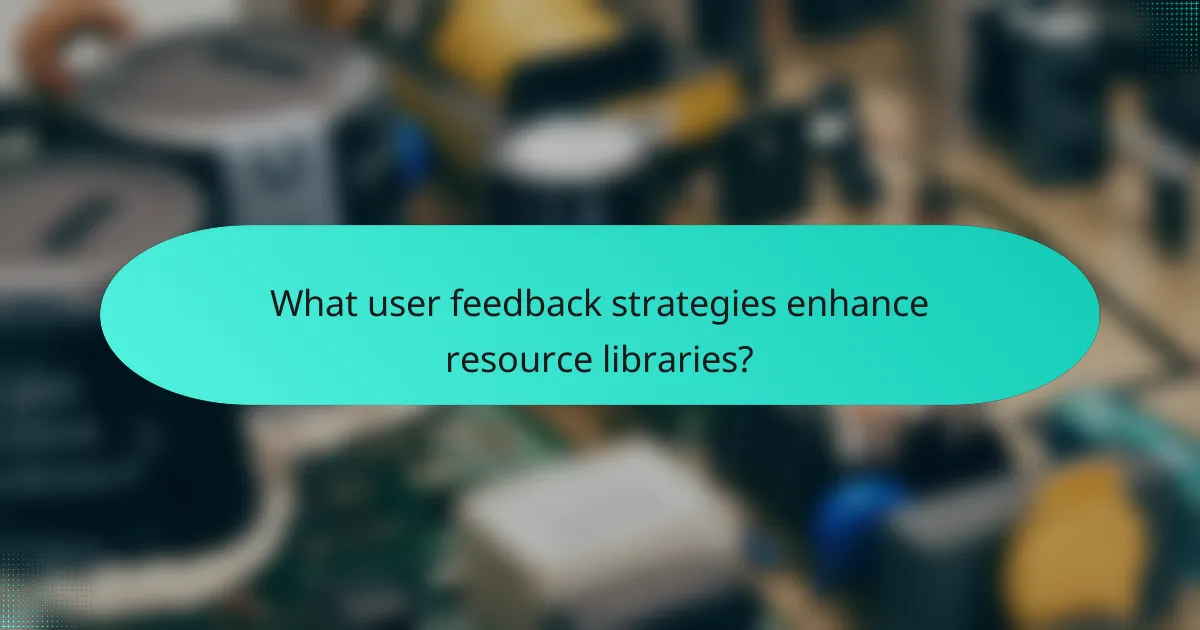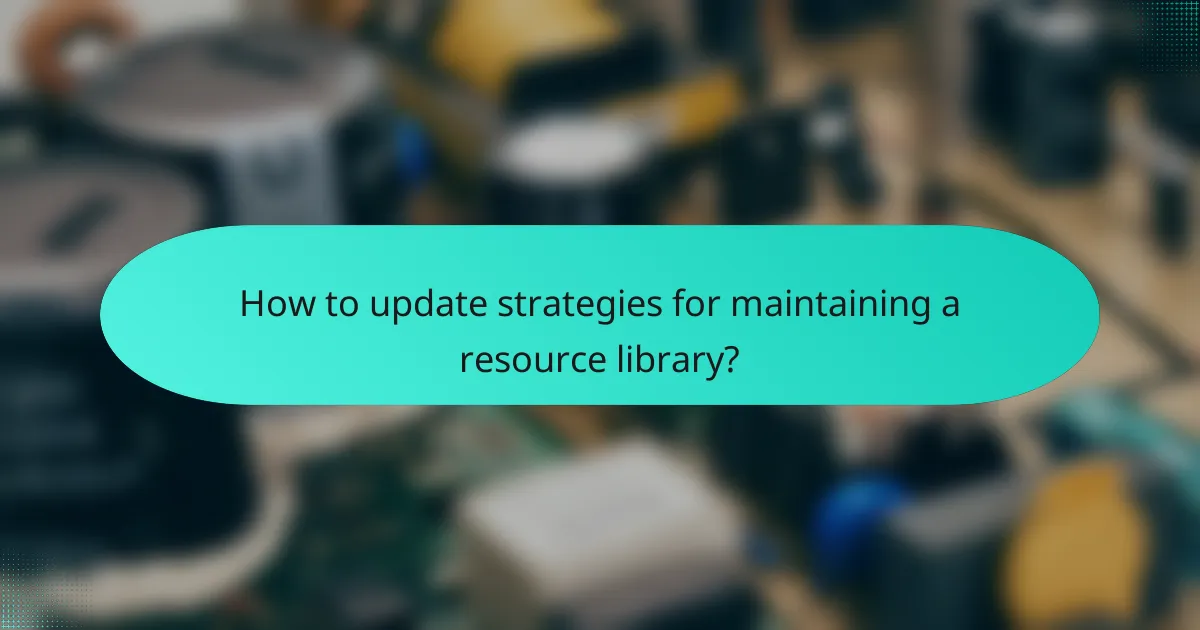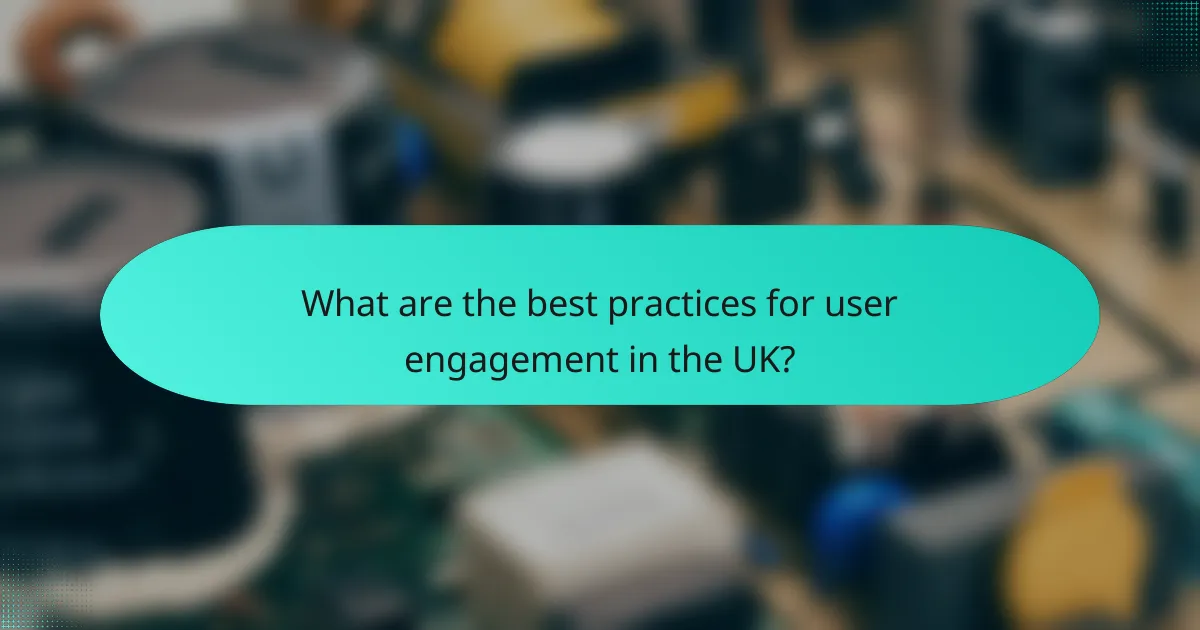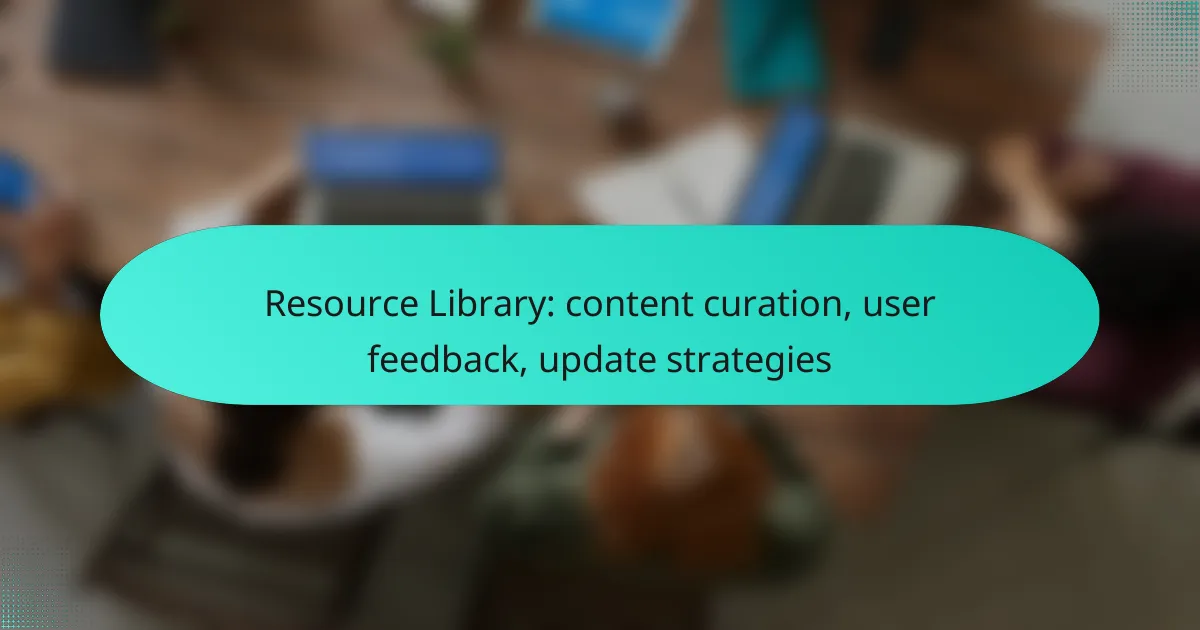A well-curated resource library is essential for meeting user needs through effective content organization and presentation. By actively seeking user feedback and employing strategic updates, libraries can continuously refine their offerings, ensuring relevance and enhancing user engagement. This approach not only improves the overall experience but also solidifies the library’s role as a valuable information hub.

How to curate content effectively for a resource library?
Effective content curation for a resource library involves systematically gathering, organizing, and presenting relevant information that meets user needs. This process enhances user experience and ensures that the library remains a valuable resource.
Utilize tools like Feedly for aggregation
Using aggregation tools like Feedly allows you to streamline the process of collecting content from various sources. These tools can pull in articles, blogs, and news updates based on your specified topics, making it easier to stay informed.
Consider setting up multiple feeds for different subject areas within your library. This way, you can quickly access and review a wide range of content, ensuring you don’t miss important updates or trends.
Implement tagging systems for organization
Tagging systems are essential for organizing content in a resource library. By assigning relevant tags to each piece of content, users can easily filter and find information that meets their specific interests or needs.
Develop a consistent tagging strategy that includes broad categories as well as more specific sub-tags. For example, if your library covers technology, tags could include ‘AI’, ‘Cybersecurity’, and ‘Software Development’. This structured approach enhances discoverability and user navigation.
Engage with user-generated content
Incorporating user-generated content can significantly enrich your resource library. This includes reviews, comments, and contributions from users, which provide diverse perspectives and insights.
Encourage users to submit their own content or feedback by creating a simple submission process. Highlighting user contributions not only fosters community engagement but also keeps your library dynamic and relevant.

What user feedback strategies enhance resource libraries?
User feedback strategies that enhance resource libraries include conducting surveys and analyzing user behavior. These methods provide valuable insights into user preferences and engagement, helping to refine content and improve overall user experience.
Conduct surveys using Typeform
Typeform is an effective tool for creating engaging surveys that can capture user feedback on resource libraries. By designing concise and visually appealing surveys, you can gather insights on user satisfaction, content relevance, and desired features.
Consider using a mix of multiple-choice questions and open-ended responses to gain both quantitative and qualitative data. Aim for a completion time of under five minutes to encourage participation.
To maximize response rates, promote your survey through email newsletters or social media channels. Offering small incentives, like discounts or access to exclusive content, can also boost engagement.
Analyze user behavior with Google Analytics
Google Analytics provides powerful insights into how users interact with your resource library. By tracking metrics such as page views, bounce rates, and average session duration, you can identify which resources are most popular and which may need improvement.
Set up goals and funnels to monitor user journeys and understand where users drop off. This can help you pinpoint areas for enhancement, such as content layout or navigation issues.
Regularly review your analytics data to stay informed about changing user behaviors and preferences. This ongoing analysis will enable you to adapt your resource library effectively and keep it aligned with user needs.

How to update strategies for maintaining a resource library?
Updating strategies for maintaining a resource library involves regularly assessing content relevance and integrating new materials. This ensures that users have access to the most current and useful information, enhancing their experience and engagement.
Schedule regular content audits
Regular content audits are essential for identifying outdated or irrelevant materials in your resource library. Aim to conduct these audits at least once or twice a year, depending on the volume of content and user feedback.
During an audit, evaluate each resource based on criteria such as accuracy, relevance, and user engagement. Consider using a checklist that includes factors like publication date, user ratings, and alignment with current trends.
After the audit, prioritize updates or removals based on the findings. This proactive approach can help maintain the integrity of your library and ensure users find valuable resources consistently.
Incorporate seasonal content updates
Incorporating seasonal content updates keeps your resource library fresh and relevant throughout the year. Tailor updates to align with holidays, events, or industry trends that resonate with your audience.
For example, if your library serves educators, consider adding resources related to back-to-school themes in late summer or holiday activities in December. This strategy not only attracts user interest but also encourages repeat visits.
To implement seasonal updates effectively, create a content calendar that outlines key dates and associated themes. This will help you plan and allocate resources efficiently, ensuring timely updates that enhance user engagement.

What are the best practices for user engagement in the UK?
Effective user engagement in the UK involves creating meaningful interactions that resonate with your audience. This can be achieved through various strategies, including hosting webinars and developing interactive content.
Host webinars with industry experts
Webinars are a powerful tool for user engagement, allowing direct interaction between experts and participants. By inviting industry leaders to share insights, you can attract a larger audience and foster a sense of community.
Consider scheduling webinars at times that accommodate your target audience, typically during weekday evenings or lunchtime. Promote these events through social media and email newsletters to maximize attendance.
Ensure that your webinars are interactive by including Q&A sessions and polls. This not only keeps participants engaged but also provides valuable feedback on their interests and concerns.
Create interactive content like quizzes
Interactive content, such as quizzes, can significantly enhance user engagement by making the experience more enjoyable and personalized. Quizzes can help users assess their knowledge or preferences, leading to a deeper connection with your content.
When designing quizzes, keep them concise and relevant to your audience’s interests. Aim for a completion time of 2-5 minutes to maintain user attention. Use engaging visuals and clear instructions to guide participants through the process.
After users complete a quiz, provide instant feedback or results that they can easily share on social media. This not only encourages participation but also promotes your brand organically.

How to measure the success of a resource library?
Measuring the success of a resource library involves analyzing user engagement and content performance. Key metrics include user interaction rates, feedback, and the effectiveness of content in meeting user needs.
Track engagement metrics through Hotjar
Hotjar provides tools to track user engagement metrics such as heatmaps, session recordings, and surveys. These features help visualize how users interact with your resource library, allowing you to identify popular content and areas needing improvement.
To effectively use Hotjar, set clear goals for what you want to measure, such as page views or click rates. Regularly review the data to spot trends and adjust your content strategy accordingly. Avoid overwhelming users with too many surveys; instead, focus on key moments in their journey.
Evaluate content performance with SEMrush
SEMrush offers insights into content performance through keyword analysis, traffic estimates, and competitive benchmarking. By evaluating how your resources rank for relevant keywords, you can assess their visibility and effectiveness in attracting users.
Utilize SEMrush to track organic traffic growth and identify high-performing content. Regularly update your library based on these insights to ensure it remains relevant and valuable. Be cautious of focusing solely on traffic; also consider user feedback to gauge satisfaction and engagement.

What tools can assist in content curation?
Several tools can enhance content curation by streamlining the process of discovering, saving, and sharing valuable information. Utilizing the right tools can help you stay updated on relevant topics and efficiently organize your findings.
Use Pocket for saving articles
Pocket is an excellent tool for saving articles, videos, and web pages for later reading. It allows users to curate content from various sources and access it across multiple devices, making it easy to organize information in one place.
To get started, simply install the Pocket browser extension or app, and save content with a click. You can tag saved items for easy retrieval and even read them offline, which is useful for on-the-go access.
Leverage BuzzSumo for trending topics
BuzzSumo is a powerful platform for identifying trending topics and popular content within your niche. It analyzes social media shares and engagement metrics to help you discover what resonates with your audience.
By entering keywords or phrases related to your interests, you can view the most shared articles, videos, and infographics. This insight enables you to curate content that aligns with current trends, ensuring your resources remain relevant and engaging.
